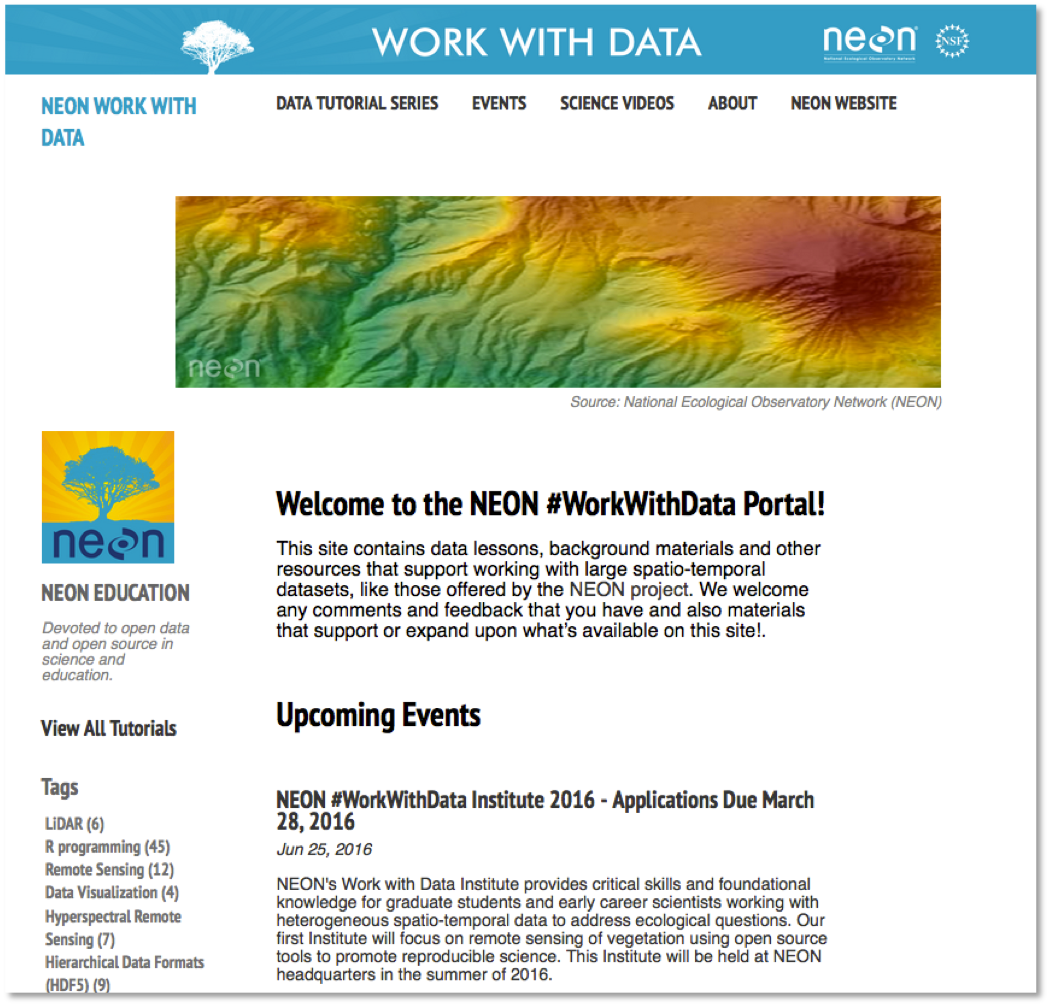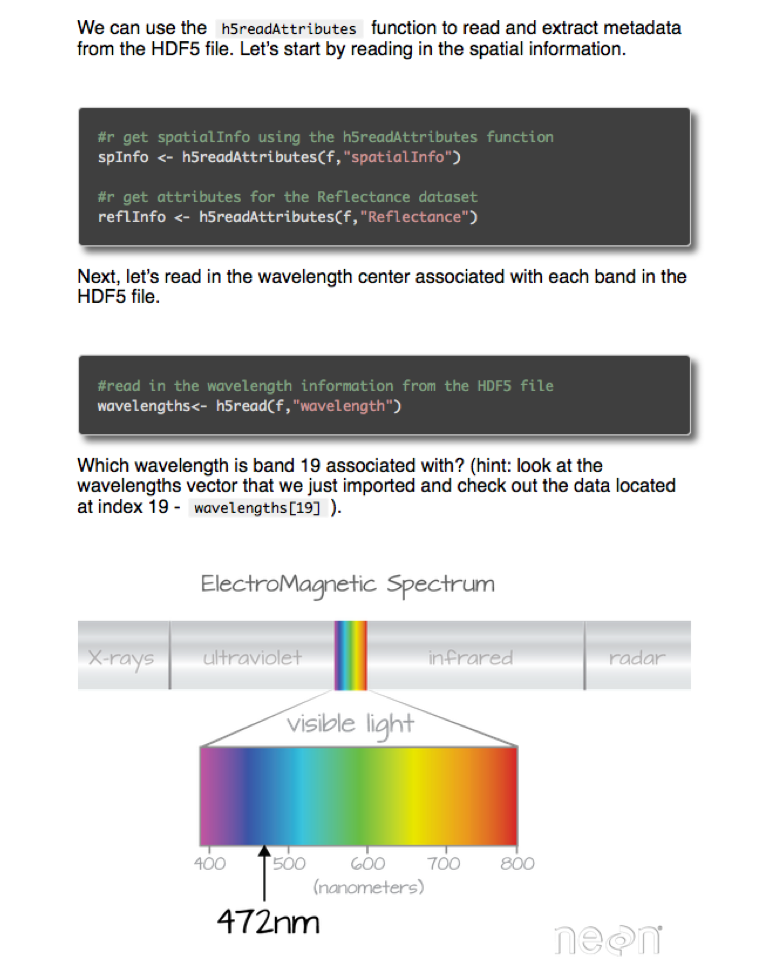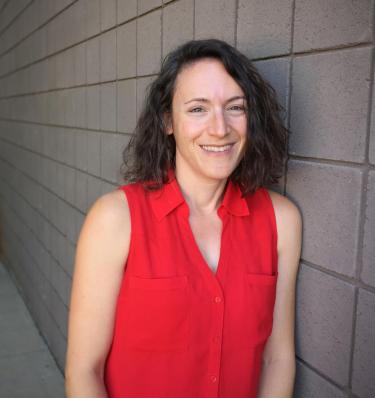How a Scientist Got Hooked on Open Education for Earth Data Science
Back in 2013, I was working at the National Ecology Observatory Network with the task of building an education program that could support a National Observatory. At the time we were hosting workshops at conferences however, that model was hardly scalable. Oh and there was one minor important-to-emphasize catch to this task. My team included exactly three staff:
me, myself and I.
As I became more familiar with the Carpentries (Software Carpentry at the time with Data Carpentry just a well-supported concept underway) I saw the power of publishing education focused content online as a way to scale a national or international program. I was also shown the power of GitHub and GitHub pages as a way to quickly build and host a website - for free!
Free fit well into my budget at the time. So I dove into the task of building
a simple portal, using a stock, but insanely awesome and flexible github pages
theme (minimal-mistakes) portal website. It looks something like this:

Education at the Intersection of Science and Data Science - Environmental Data Science
The lessons that I began to post on the portal were teaching two things:
- Science concepts associated with why you would want to use NEON data
- Data science techniques for opening, processing and plotting NEON data (but that also were general enough to use on any other data in a similar format!)
- Data structure concepts such as what is a raster? or What are important things to know about spatial data?
Lessons contained a mixture of code and images. The website took advantage of workshops that we had given at conferences like ESA (Ecological Society of America) and created content that could be used and reused not only during a workshop but by anyone, at any time and in any location around the world.

I started by posting a few lessons. Over time a few turned into a dozen. A dozen turned into a hundred with the goal of staff all across NEON contributing content to our learning portal.
I was an Open Educator and Didn’t Even Know It
At the time, I was publishing lessons online because:
- I felt strongly that a federally funded observatory should be sharing everything that they produce with everyone and
- It was a way to scale our program.
What I didn’t know is that there was a movement underway surrounding Open Education. You see:
- Higher education can be expensive. Open education resources lower the barrier of entry for many people who can not afford to enroll in courses.
- It also is useful in classroom settings to keep textbook costs down.
- Even if people have funds to attend school, sometimes the schools in the preferred geographic region do not teach the content that they want to learn. Particularly if it is new or cutting edge.
Open education also known as Universal education seeks to lower the barriers to learning. It further democratizes access to content.
From a practical standpoint, technology changes. Online content supports a more dynamically adaptable presentation of lessons than a printed textbook.
I could go on but hopefully you get the point.
Open education is cool and is the way to go if you can do so.
So back to the portal…
If You Build It, They May Not Come - How You Can Help People Find Your Website
I had some experience working on website development over the years but really
I was flying by the seat of my pants when it came to helping people find our
content. One thing I had been told in the past was that websites that have
lots of content around a particular area of interest (for example remote sensing
or R often get ranked higher in search engines). With that tidbit of information
I decided to build pages that grouped content by categories to see if it would
get Google’s attention.
It worked.

Within a year and a half of publishing the NEON Data Skills portal, we had over 2,000 unique users a week visiting our site from all across the globe. As someone who is most motivated by activities that impact others in useful and supportive ways, this made me psyched!
The NEON data skills portal has now migrated over to the NEON website so and I have since moved on to build an even bigger portal:
https://www.earthdatascience.org at the University of Colorado Boulder. More on that experience in another blog!
But I learned a lot from everything that I did at NEON, and have a few tips to share from it.
Three Tips for Building A Discoverable Open Education Website for Scientists
1. Make Sure Your Content Has a Theme:
It’s ok if you don’t have a fancy graphic design or even a photoshop license. Consider the types of materials that you want to publish and group them to demonstrate to search engines that you are good at writing about that topic. The main theme of the NEON site was lessons that were about using NEON data and learning data science in the context of the science. Some subthemes from the NEON website that were used to spark Google’s attention included:
- spatial data in
R - remote sensing
- raster data in
R
The above topics happened to be ones that were used frequently by people in Google
searches. And so over time the NEON data skills website gained more visibility
and a higher “rank” - particular in areas related to using the R scientific
programming language.
2. If you are writing about code and/or data, provide useful, reproducible examples
When I say reproducible, I mean that someone can copy the code from your lesson and download, get or easily create the data needed to run the code.
Your reader should have everything that they need in your post to run the workflow from start to finish. Yes, this means that your open education resources ALSO need to be fully reproducible!
To really enforce this idea, I created an automated continuous integration build at CU boulder to ensure that every lesson that we published ran from start to finish in the cloud (in a new, clean environment) because any lesson was published online for our audience! Stay tuned for more on how this worked.
There is nothing more frustrating then trying to run a workflow in an online lesson and quickly discovering that it just doesn’t work.
3. Carefully Consider Your Audience
Consider who you want to use the lessons on your site and make sure the content accommodates their needs. For instance when I think about data science, I immediately think about how much I expect a user on the website to know before reading my lesson. Avoid too much jargon and if you do use jargon, define the terms carefully.
Last but not least, plan on maintaining the content, or don’t publish it at all!
I’ll devote another blog to this topic but the idea behind open education is that the resources bring value to the community. We know that software and technology changes over time. And as those changes happen, the way we process data changes too.
Open education materials require maintenance in the same way that software or any other technology does. So if you have a budget, plan to maintain your lessons over time rather than writing more new stuff!
Stay tuned as i’ll write another post about this very topic and how I developed a testing (continuous integration) system for the next portal that I build at CU Boulder.
Comments?
Share on
Twitter Facebook LinkedInOther articles that you might enjoy...
Why You Shouldn’t Publish Open Education Resources (Or Should You?): Earth and Environmental Data Science
There is a huge number of open education / online tutorials that teach earth and environmental data science skills. However, these lessons will quickly become obsolete as tools evolve. This blog is about why simply publishing a lesson online is not enough.
How I Became an Open Education Advocate for Earth and Environmental Data Science
The idea of Open Education Resources (OER) and the field of earth and environmental sciences are not new. But the terms have become popular in recent years. While I only recently identified with these terms, i've been working in this space for years. Here I talk about how I discovered open education in the context of building online resources.
Three Tips for Building A Discoverable Open Education Website for Scientists
Open Education Resources (OER) referred to lessons and materials that are published online for anyone to use. Here I present a few lessons learned from my experiences.
